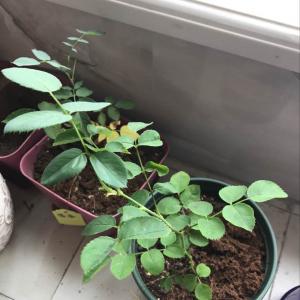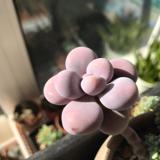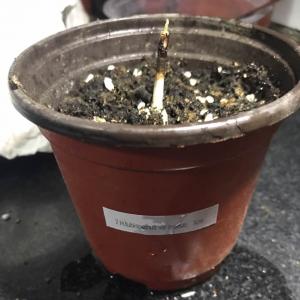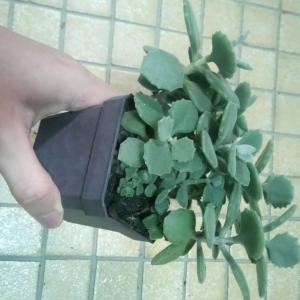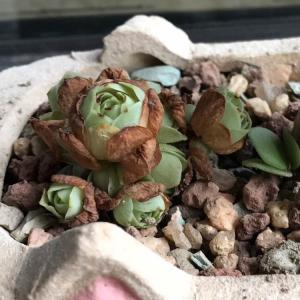成长记
lrgarden
2017年08月05日

我新添加了一棵“绿萝2”到我的“花园”
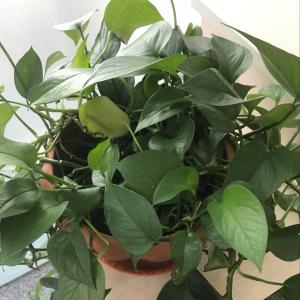

6
0
lrgarden:@一颗糖 🙀
lrgarden:@meriunkat nothing else, your plants is fine, have fun here.
一颗糖:评论好溜,点个赞
meriunkat:@lrgarden oh sorry I don't have Facebook lol, what was it you wanted to tell me? was it something about one of my plants?
lrgarden:@meriunkat you can follow gfinger's Facebook or feedback in app
显示更多
文章
Miss Chen
2017年08月05日


Description: This annual plant is 1–2½' tall, branching occasionally. It has a tendency to sprawl in the absence of supportive vegetation. The dark green stems are grooved and hairless. The opposite leaves are 1-3" long, dark green, and linear. They have smooth margins and a prominent midvein. The leaves are usually hairless, although new growth may be slightly pubescent. Secondary leaves may develop from the axils of the primary leaves along the central stem, but they are smaller in size than the latter. Some of the upper stems develop racemes of flowers. These flowers are up to 1" long and across, and vary in color from lavender to purple.
The corolla of each flower is tubular and has 5 spreading lobes that are ciliate, consisting of 2 upper lobes, 2 sides lobes, and a lower lobe. Within the throat of the corolla there are specks of dark purple and 2 patches of pale yellow. There are abundant white hairs within the corolla where the reproductive organs are located. The anthers are pale yellow and the narrow style is white. The green calyx is tubular and divided into 5 triangular lobes. These lobes are one-half the length of the calyx tube or less. The calyx is hairless and has little or no reticulation. The blooming period occurs from late summer until the fall, and lasts about a month. There is no noticeable floral scent. After the flowers are fertilized and wither away, there develops rounded capsules that are a little longer than the calyx tube. These capsules contain numerous tiny seeds. When the capsules split open at the top, gusts of wind can distribution the seeds a considerable distance. The root system is fibrous and possibly parasitic on other species of plants. Purple False Foxglove spreads by reseeding itself, and does not reproduce vegetatively.
Cultivation: The preference is full or partial sun, and moist soil that is sandy or peaty. Because the seeds are small, young plantlets may wither away if they are allowed to become too dry. A soil with an acid pH is preferred.
Stem & Leaves
Range & Habitat: Purple False Foxglove occurs occasionally throughout Illinois (see Distribution Map), where it is native. This is one of the more common Agalinis spp. in the state. Habitats include moist sand prairies, sandy savannas, paths and openings in sandy woodlands, boggy areas, and interdunal sandflats near Lake Michigan. This plant appears to thrive in areas with occasional disturbance as this removes some of the competing vegetation.
Faunal Associations: Bumblebees, digger bees (Melissodes spp.), and leaf-cutting bees (Megachile spp.) visit the flowers for nectar and pollen. The caterpillars of the butterfly Junonia coenia (Buckeye) feed on the foliage. A flea beetle, Kuschelina fallax, feeds on a very similar species, Agalinis fasciculata (Beach False Foxglove), and it is possible that this flea beetle feeds on other Agalinis spp., including Purple False Foxglove. Very little appears to be known about the relationships of these plants to mammalian herbivores as sources of food.
Photographic Location: Along a path in a sandy savanna at Hooper Branch Savanna Nature Preserve in Iroquois County, Illinois, where this plant species is locally abundant.
Comments: The flowers are quite attractive and produced in abundance during the late summer or fall. At one time the scientific name for this species was Gerardia purpurea, but the purple-flowered false foxgloves were reassigned to the genus Agalinis, while the yellow-flowered false foxgloves were reassigned to the genus Aureolaria. Distinguishing the different Agalinis spp. can be tricky as they have similar foliage and flowers. Purple False Foxglove has larger flowers (up to 1" long and across) than some other Agalinis spp. and they occur on pedicels (flowering stalks) that are shorter than the tubular calyx (the pedicels are about 1/8" long). The flowers are always some shade of purple or lavender, while the flowers of some Agalinis spp. are often pinkish in appearance. Purple False Foxglove is quite similar in appearance to Agalinis fasciculata (Beach False Foxglove), however this latter species has secondary leaves that are nearly as large as the primary leaves (i.e., the leaves appear to be whorled along the major stems). If they are present, such secondary leaves are smaller in size than the primary leaves in Purple False Foxglove.

0
0
文章
Dummer. ゛☀
2017年08月03日

Family - Asteraceae
Stems - To 1m tall, erect, herbaceous, fro a vertical caudex and slightly thickened roots, terete, glabrescent basally, hispidulous with multicellular hairs in the apical 1/2.
Leaves - Alternate, the basal and lower-most petiolate, sessile above. Petioles of the basal leaves to +20cm long, with a very narrow adaxial groove, mostly glabrous but with some hairs in the groove. Blades to +/-20cm long, +/-8cm broad, scabrous above and below, greyish because of dense hairs below, elliptic-lanceolate, shallow serrate, acute, tapering slightly at the base. Cauline leaves sessile, quickly reduced upward, shallow crenate-serrate, densely pubescent (with a greyish cast), scabrous, those in the middle of the stem oblanceolate. Leaves in the apical 1/3 of the stem reduced to bracts, ovate to orbicular.
Inflorescence - Terminal corymbiform arrangement of flowerheads. Peduncles densely hispidulous. Each division of the inflorescence subtended by a small foliaceous bract.
Involucre - To +8mm long (tall), 5mm in diameter, cylindric. Phyllaries imbricate, appressed, unequal, the longest to 6mm long, 2mm broad, rounded at the apex, greenish (mostly at the apex), scarious below, with a green midrib, glabrous internally and externally, with ciliolate margins, oblong.
Ray flowers - Flowers 8-10 per flowerhead, fertile, pistillate. Corolla tube 4mm long, glabrous, yellowish. Ligule 4mm long, 2mm broad, yellow, glabrous or with a few sparse hairs, rounded at the apex. Style purplish, glabrous, thin, 5mm long, bifurcate. Stigmas 1mm long. Pappus of capillary bristles, white, 5mm long. Bristles antrorse barbellate. Achene green in flower, 2.2mm long, ribbed, glabrous.
Disk flowers - Disk corollas yellow, contracted and thin in the basal 2/3, expanded in the upper 1/3, 5mm long, 5-lobed, glabrous or with a few small hairs. Lobes acute, spreading, 1.1mm long. Stamens 5, adnate in the basal 1/3 of the corolla tube. Filaments glabrous, compressed, thin, glabrous, yellowish. Anthers yellow, 2.5mm long, connate around the style, partially to wholly exserted, acute at the apices. Style exserted, purplish, bifurcate for about 1mm. Stigmas erect (mostly). Pappus and achenes as the ray flowers.
Flowering - August - October.
Habitat - Prairies, glades, rocky open ground, thickets, borders of wet meadows.
Origin - Native to U.S.
Other info. - This showy species can be found throughout most of Missouri but is apparently absent in the southeast corner of the state. The plant is easy to identify in the field because of its big basal leaves and large, showy flowerheads. It has larger flowerheads than any other Solidago species in Missouri. This is a characteristic plant of prairies and is certainly worthy of cultivation as it is drought tolerant and requires little care.
Stems - To 1m tall, erect, herbaceous, fro a vertical caudex and slightly thickened roots, terete, glabrescent basally, hispidulous with multicellular hairs in the apical 1/2.

Leaves - Alternate, the basal and lower-most petiolate, sessile above. Petioles of the basal leaves to +20cm long, with a very narrow adaxial groove, mostly glabrous but with some hairs in the groove. Blades to +/-20cm long, +/-8cm broad, scabrous above and below, greyish because of dense hairs below, elliptic-lanceolate, shallow serrate, acute, tapering slightly at the base. Cauline leaves sessile, quickly reduced upward, shallow crenate-serrate, densely pubescent (with a greyish cast), scabrous, those in the middle of the stem oblanceolate. Leaves in the apical 1/3 of the stem reduced to bracts, ovate to orbicular.

Inflorescence - Terminal corymbiform arrangement of flowerheads. Peduncles densely hispidulous. Each division of the inflorescence subtended by a small foliaceous bract.
Involucre - To +8mm long (tall), 5mm in diameter, cylindric. Phyllaries imbricate, appressed, unequal, the longest to 6mm long, 2mm broad, rounded at the apex, greenish (mostly at the apex), scarious below, with a green midrib, glabrous internally and externally, with ciliolate margins, oblong.

Ray flowers - Flowers 8-10 per flowerhead, fertile, pistillate. Corolla tube 4mm long, glabrous, yellowish. Ligule 4mm long, 2mm broad, yellow, glabrous or with a few sparse hairs, rounded at the apex. Style purplish, glabrous, thin, 5mm long, bifurcate. Stigmas 1mm long. Pappus of capillary bristles, white, 5mm long. Bristles antrorse barbellate. Achene green in flower, 2.2mm long, ribbed, glabrous.
Disk flowers - Disk corollas yellow, contracted and thin in the basal 2/3, expanded in the upper 1/3, 5mm long, 5-lobed, glabrous or with a few small hairs. Lobes acute, spreading, 1.1mm long. Stamens 5, adnate in the basal 1/3 of the corolla tube. Filaments glabrous, compressed, thin, glabrous, yellowish. Anthers yellow, 2.5mm long, connate around the style, partially to wholly exserted, acute at the apices. Style exserted, purplish, bifurcate for about 1mm. Stigmas erect (mostly). Pappus and achenes as the ray flowers.
Flowering - August - October.
Habitat - Prairies, glades, rocky open ground, thickets, borders of wet meadows.
Origin - Native to U.S.
Other info. - This showy species can be found throughout most of Missouri but is apparently absent in the southeast corner of the state. The plant is easy to identify in the field because of its big basal leaves and large, showy flowerheads. It has larger flowerheads than any other Solidago species in Missouri. This is a characteristic plant of prairies and is certainly worthy of cultivation as it is drought tolerant and requires little care.
0
0
文章
Dummer. ゛☀
2017年08月03日

Family - Asteraceae
Stems - To -1m tall, branching in upper 1/2, herbaceous, erect, short pubescent, minutely winged (ribbed) from leaf bases, from rhizomes.
Leaves - Alternate, sessile, linear, 3-5 nerved, entire, slightly scabrous, acute to acuminate, to +/-10cm long, 8-9mm broad, reduced upward by inflorescence, glandular-punctate (use a lens to see).
Inflorescence - Corymbose arrangement of flower heads. Peduncles winged and pubescent to strigose on wing margins.
Involucre - 5mm tall, 2mm in diameter, cylindrical. Phyllaries imbricate, glabrous, yellowish and often with green apices (viewed with a lens you can see a yellow midvein in the green tip), linear, with scarious margins. Innermost phyllaries to 3.1mm long, .6mm broad.
Ray flowers - Fertile. Ligule yellow, to -3mm long, .5mm broad, glabrous. Achene (in flower) white, .5mm long, pubescent. Pappus of capillary bristles.
Disk flowers - 15-20 per flowerhead. Corolla tube to 2mm long, pale yellow, 5-lobed. Lobes yellow, 1.3mm long, acute, glabrous. Stamens 5, adnate 1/2 way up corolla tube. Anthers yellow, connate around style, included, 1.4mm long. Style bifurcate, just exserted beyond corolla lobes. Achene pubescent, .7mm long (in flower). Pappus of capillary bristles to 3.4mm long.
Flowering - August - October.
Habitat - Prairies, fields, railroads.
Origin - Native to U.S.
Other info. - graminifolia means "grass-leaf" and indeed the leaves on this species are thin and long, much like grass blades. This species is most common in the northeastern 1/4 of Missouri but is scattered in counties through the upper 1/2 of the state.
Steyermark gives two varieties for the plant. Variety media (Greene) Harris, is pictured and described above. Variety nuttallii (Greene) Fern., has leaves which are typically pubescent and more broad than the previous variety.
Stems - To -1m tall, branching in upper 1/2, herbaceous, erect, short pubescent, minutely winged (ribbed) from leaf bases, from rhizomes.
Leaves - Alternate, sessile, linear, 3-5 nerved, entire, slightly scabrous, acute to acuminate, to +/-10cm long, 8-9mm broad, reduced upward by inflorescence, glandular-punctate (use a lens to see).

Inflorescence - Corymbose arrangement of flower heads. Peduncles winged and pubescent to strigose on wing margins.
Involucre - 5mm tall, 2mm in diameter, cylindrical. Phyllaries imbricate, glabrous, yellowish and often with green apices (viewed with a lens you can see a yellow midvein in the green tip), linear, with scarious margins. Innermost phyllaries to 3.1mm long, .6mm broad.

Ray flowers - Fertile. Ligule yellow, to -3mm long, .5mm broad, glabrous. Achene (in flower) white, .5mm long, pubescent. Pappus of capillary bristles.
Disk flowers - 15-20 per flowerhead. Corolla tube to 2mm long, pale yellow, 5-lobed. Lobes yellow, 1.3mm long, acute, glabrous. Stamens 5, adnate 1/2 way up corolla tube. Anthers yellow, connate around style, included, 1.4mm long. Style bifurcate, just exserted beyond corolla lobes. Achene pubescent, .7mm long (in flower). Pappus of capillary bristles to 3.4mm long.

Flowering - August - October.
Habitat - Prairies, fields, railroads.
Origin - Native to U.S.
Other info. - graminifolia means "grass-leaf" and indeed the leaves on this species are thin and long, much like grass blades. This species is most common in the northeastern 1/4 of Missouri but is scattered in counties through the upper 1/2 of the state.
Steyermark gives two varieties for the plant. Variety media (Greene) Harris, is pictured and described above. Variety nuttallii (Greene) Fern., has leaves which are typically pubescent and more broad than the previous variety.
0
0
文章
Dummer. ゛☀
2017年08月03日

Family - Asteraceae
Stems - To +2m tall, erect, stout, terete, puberulent, to +/-1cm in diameter at the base, from slender rhizomes, typically branching in the apical 1/2, herbaceous.
Leaves - Alternate, sessile or on petioles to +/-2mm long, many on the stem, widest in the middle portion of the stem. Basal leaves absent at anthesis. Blades to 15cm long, +2cm broad, shallow serrate, pubescent abaxially, scabrous adaxially from antrorse strigillose hairs or glabrous, green above, lighter below, linear-lanceolate.
Inflorescence - Terminal pyramidal paniculate inflorescence of many branches and flower heads. Inflorescence to +15cm broad , +20cm tall. Flower heads secund in few to many-flowered axillary panicles on the inflorescence branches. Each small group subtended by a linear bract. Each flower head subtended by a minute subulate bract. Bracts, peduncles, and branches of the inflorescence pubescent. Peduncles of each flower head to 1mm long.
Involucre - To 3-5mm tall, 1-1.5mm broad, light-green, pale yellow, or whitish. Phyllaries imbricate, linear, glabrous, 1-2mm long, .5mm broad.
Ray flowers - +/-5 per head, yellow, pistillate. Ligule yellow, glabrous, to 2mm long, .5mm broad, notched at the apex. Corolla tube to 3mm long, translucent-yellow, with a few translucent hairs at the apex. Style yellowish, bifurcate for +/-1mm, +3mm long, glabrous. Pappus white, uniseriate, of capillary bristles, antrorse barbellate, +/-3mm long. Achenes (in flower) retrorse pubescent. Mature achenes not seen.
Disk flowers - Flowers 1-3 per head, yellow, 5-lobed. Lobes spreading, linear-ovate to subulate, +/-1mm long, glabrous, yellow. Corolla tube +2mm long, glabrous externally and internally, pale yellow to whitish. Style 1, yellow, glabrous, exserted, to +/-3mm long, mostly undivided. Stamens 5. Anthers small, included, reddish, -1mm long, -.3mm broad. Filaments translucent, glabrous, -2mm long, adnate at the base of the corolla tube. Pappus as in the ray flowers.
Flowering - August - November.
Habitat - Fallow fields, prairies, bottoms, rocky outcrops, open woods, thickets, waste ground, roadsides, railroads.
Origin - Native to U.S.
Other info. - This is one the most common species of goldenrod in Missouri. The plant grows quite large ("altissima" means "tall") and can be seen along nearly every roadside of the state in the fall.
This species is in the group of tall Goldenrods which includes other similar species like S. gigantea Ait. and S. canadensis L.. These species have no basal rosettes at anthesis and have leaves which are largest in the central portion of the stem but are typically all similar in size. The best way to differentiate these species is vegetatively and Justin Thomas has written an excellent key to the Solidago species based on vegetative characters only. You can acquire a copy of this key in the 2003 issue of Missouriensis, a publication of the Missouri Native Plant Society.
S. altissima can be identified by its pubescent stems, three-nerved leaves, pyramid-shaped inflorescences, and small flowerheads, which are only about 3-5mm tall.
Stems - To +2m tall, erect, stout, terete, puberulent, to +/-1cm in diameter at the base, from slender rhizomes, typically branching in the apical 1/2, herbaceous.

Leaves - Alternate, sessile or on petioles to +/-2mm long, many on the stem, widest in the middle portion of the stem. Basal leaves absent at anthesis. Blades to 15cm long, +2cm broad, shallow serrate, pubescent abaxially, scabrous adaxially from antrorse strigillose hairs or glabrous, green above, lighter below, linear-lanceolate.

Inflorescence - Terminal pyramidal paniculate inflorescence of many branches and flower heads. Inflorescence to +15cm broad , +20cm tall. Flower heads secund in few to many-flowered axillary panicles on the inflorescence branches. Each small group subtended by a linear bract. Each flower head subtended by a minute subulate bract. Bracts, peduncles, and branches of the inflorescence pubescent. Peduncles of each flower head to 1mm long.

Involucre - To 3-5mm tall, 1-1.5mm broad, light-green, pale yellow, or whitish. Phyllaries imbricate, linear, glabrous, 1-2mm long, .5mm broad.
Ray flowers - +/-5 per head, yellow, pistillate. Ligule yellow, glabrous, to 2mm long, .5mm broad, notched at the apex. Corolla tube to 3mm long, translucent-yellow, with a few translucent hairs at the apex. Style yellowish, bifurcate for +/-1mm, +3mm long, glabrous. Pappus white, uniseriate, of capillary bristles, antrorse barbellate, +/-3mm long. Achenes (in flower) retrorse pubescent. Mature achenes not seen.
Disk flowers - Flowers 1-3 per head, yellow, 5-lobed. Lobes spreading, linear-ovate to subulate, +/-1mm long, glabrous, yellow. Corolla tube +2mm long, glabrous externally and internally, pale yellow to whitish. Style 1, yellow, glabrous, exserted, to +/-3mm long, mostly undivided. Stamens 5. Anthers small, included, reddish, -1mm long, -.3mm broad. Filaments translucent, glabrous, -2mm long, adnate at the base of the corolla tube. Pappus as in the ray flowers.
Flowering - August - November.
Habitat - Fallow fields, prairies, bottoms, rocky outcrops, open woods, thickets, waste ground, roadsides, railroads.
Origin - Native to U.S.
Other info. - This is one the most common species of goldenrod in Missouri. The plant grows quite large ("altissima" means "tall") and can be seen along nearly every roadside of the state in the fall.
This species is in the group of tall Goldenrods which includes other similar species like S. gigantea Ait. and S. canadensis L.. These species have no basal rosettes at anthesis and have leaves which are largest in the central portion of the stem but are typically all similar in size. The best way to differentiate these species is vegetatively and Justin Thomas has written an excellent key to the Solidago species based on vegetative characters only. You can acquire a copy of this key in the 2003 issue of Missouriensis, a publication of the Missouri Native Plant Society.
S. altissima can be identified by its pubescent stems, three-nerved leaves, pyramid-shaped inflorescences, and small flowerheads, which are only about 3-5mm tall.
0
0
文章
Dummer. ゛☀
2017年08月03日

Family - Brassicaceae
Stems - Herbaceous, erect, from rhizomes, glabrous, green or becoming purple in the strong sun, ribbed, to +/-35cm tall, branching.
Leaves - Alternate, petiolate, deeply pinnatifid. Basal leaves to -10cm long, 2-2.5cm broad, with +/-6 main divisions per side. Cauline leaves similar but reduced. All leaves glabrous or with very few short hairs. Divisions of the leaves toothed. Upper leaves with thinner and fewer divisions than the lower. Tissue connecting the divisions of the leaves .2-.3mm broad (use a lens to see).
Inflorescence - Terminal and axillary racemes to +10cm long. Axis glabrous. Pedicels to 4mm long in flower, expanding to +/-1cm long in fruit, glabrous. Inflorescence compact in flower, quickly expanding. Siliques to 1cm long, 1mm in diameter, cylindric but slightly compressed, glabrous, with a beak to 1mm long.
Flowers - Petals 4, distinct, spatulate, yellow, glabrous, to +4mm long, 1.5mm broad, rounded at the apex. Stamens 6, erect, 4 larger and 2 smaller. Filaments yellow, glabrous, to 3mm long. Anthers yellow, 1mm long. Ovary cylindric, green-yellow, glabrous, 2mm long in flower, superior. Style .5mm long. Stigmas globose-capitate, .7mm broad. Sepals 4, distinct, yellow, erect to spreading, cupped, mostly glabrous but often with a few hairs at the apex externally, entire, 2-2.5mm long, to 1mm broad, subulate.
Flowering - May - September.
Habitat - Moist low ground, streambanks, wet fields and meadows.
Origin - Native to Europe.
Other info. - This little species can be found scattered throughout Missouri. The plant can be identified by its yellow flower petals, which are 4-8mm long, and its pinnately divided leaves, which have toothed margins. The wet habitat of the plant and its creeping stems with fibrous roots are other good characteristics to look for.
Stems - Herbaceous, erect, from rhizomes, glabrous, green or becoming purple in the strong sun, ribbed, to +/-35cm tall, branching.
Leaves - Alternate, petiolate, deeply pinnatifid. Basal leaves to -10cm long, 2-2.5cm broad, with +/-6 main divisions per side. Cauline leaves similar but reduced. All leaves glabrous or with very few short hairs. Divisions of the leaves toothed. Upper leaves with thinner and fewer divisions than the lower. Tissue connecting the divisions of the leaves .2-.3mm broad (use a lens to see).

Inflorescence - Terminal and axillary racemes to +10cm long. Axis glabrous. Pedicels to 4mm long in flower, expanding to +/-1cm long in fruit, glabrous. Inflorescence compact in flower, quickly expanding. Siliques to 1cm long, 1mm in diameter, cylindric but slightly compressed, glabrous, with a beak to 1mm long.

Flowers - Petals 4, distinct, spatulate, yellow, glabrous, to +4mm long, 1.5mm broad, rounded at the apex. Stamens 6, erect, 4 larger and 2 smaller. Filaments yellow, glabrous, to 3mm long. Anthers yellow, 1mm long. Ovary cylindric, green-yellow, glabrous, 2mm long in flower, superior. Style .5mm long. Stigmas globose-capitate, .7mm broad. Sepals 4, distinct, yellow, erect to spreading, cupped, mostly glabrous but often with a few hairs at the apex externally, entire, 2-2.5mm long, to 1mm broad, subulate.

Flowering - May - September.
Habitat - Moist low ground, streambanks, wet fields and meadows.
Origin - Native to Europe.
Other info. - This little species can be found scattered throughout Missouri. The plant can be identified by its yellow flower petals, which are 4-8mm long, and its pinnately divided leaves, which have toothed margins. The wet habitat of the plant and its creeping stems with fibrous roots are other good characteristics to look for.
0
0
文章
Dummer. ゛☀
2017年08月03日

Family - Cyperaceae
Stems - Aerial stems to -1m tall, about 2-3mm broad, erect, herbaceous, trigonous (blunt), uniformly pubescent and roughened over their entire length, from very short, knotty rhizomes.
Leaves - Blades to 60cm long, 3-7mm broad, all basal, present at anthesis, pubescent.
Inflorescence - Terminal umbel with 4-12 rays. Each ray to 15cm long, uniformly roughened and short pubescent over the entire length, 1-2mm broad. Bracts of the inflorescence +/-6, shorter than the rays, pubescent at least on the margins, spreading. Spikes 10-18mm long, with 20-100 spikelets. Spikelets dense, sessile, mostly reflexed, the bases of the spikelets not visible.
Flowers - Spikelets 6-8mm long, narrowly linear, acute to acuminate at the apex, terete to somewhat 4-angled, typically with 3 scales, glabrous, typically shed as an intact unit. Scales 4-4.5mm long, strongly overlapping, lanceolate, acute to acuminate, straw-colored to brown. Fertile florets 1-2 per spikelet. Stamens 3. Anthers .5-1mm long. Stigmas 3. Fruits 2.5-3mm long, narrowly oblong in outline, 3-angled in cross-section, with flat sides, brown, shiny, finely pebbled.
Flowering - July - September.
Habitat - Sand prairies, openings of dry upland woods.
Origin - Native to U.S.
Other info. - This species can be found in just a few southeastern Missouri counties. The plant can be identified by its dense spikes and pubescent-roughened stems and inflorescence rays.
Another species, C. retrofractus (L.) Torr., is similar but has sharply trigonous stems and inflorescence rays that are smooth to slightly roughened at the apex. This latter species is found in the same area of Missouri as C. plukenetii.
Stems - Aerial stems to -1m tall, about 2-3mm broad, erect, herbaceous, trigonous (blunt), uniformly pubescent and roughened over their entire length, from very short, knotty rhizomes.

Leaves - Blades to 60cm long, 3-7mm broad, all basal, present at anthesis, pubescent.
Inflorescence - Terminal umbel with 4-12 rays. Each ray to 15cm long, uniformly roughened and short pubescent over the entire length, 1-2mm broad. Bracts of the inflorescence +/-6, shorter than the rays, pubescent at least on the margins, spreading. Spikes 10-18mm long, with 20-100 spikelets. Spikelets dense, sessile, mostly reflexed, the bases of the spikelets not visible.

Flowers - Spikelets 6-8mm long, narrowly linear, acute to acuminate at the apex, terete to somewhat 4-angled, typically with 3 scales, glabrous, typically shed as an intact unit. Scales 4-4.5mm long, strongly overlapping, lanceolate, acute to acuminate, straw-colored to brown. Fertile florets 1-2 per spikelet. Stamens 3. Anthers .5-1mm long. Stigmas 3. Fruits 2.5-3mm long, narrowly oblong in outline, 3-angled in cross-section, with flat sides, brown, shiny, finely pebbled.

Flowering - July - September.
Habitat - Sand prairies, openings of dry upland woods.
Origin - Native to U.S.
Other info. - This species can be found in just a few southeastern Missouri counties. The plant can be identified by its dense spikes and pubescent-roughened stems and inflorescence rays.
Another species, C. retrofractus (L.) Torr., is similar but has sharply trigonous stems and inflorescence rays that are smooth to slightly roughened at the apex. This latter species is found in the same area of Missouri as C. plukenetii.
0
0
文章
Dummer. ゛☀
2017年08月02日

Family - Plantaginaceae
Stems - Plants acaulescent, from a big taproot.
Leaves - All basal, linear to linear-oblong, mostly entire but with a few small whitish tubercles on each margin, glabrous to sparse pilose adaxially, pilose abaxially, with 2-4 main side nerves (nerves run parallel to the midrib), dull-green, to 17cm long, -1cm broad, rounded to subacute at the apex.
Inflorescence - Many long-pedunculate flower spikes. Scapes to 30cm long, terete, solid, green, antrorse appressed pubescent in the upper 2/3, pilose at the base. Spikes to 7-8cm long, +/-8mm in diameter, very densely-flowered. Rachis densely pilose. Each flower subtended by 1 subulate bract. Bracts 4-5mm long, 1-1.7mm broad, green with translucent margins. Margins pilose basally.
Flowers - Sessile. Sepals 4, joined at the base, green with large translucent margins, rounded at the apex, to +4mm long, 2mm broad, pilose externally, glabrous internally, completely enveloping the ovary of the flower. Ovary green, glabrous, shiny, 4mm long, +2mm in diameter, with a transverse suture in the basal 1/3, 2-celled. Corolla 4-lobed, translucent. The two lateral lobes larger than the dorsal and ventral lobes, to +3mm long, 2-3mm broad, rounded at the apices, glabrous. Corolla tube short (-1mm long) ferruginous. Stamens 4, adnate to the corolla tube, alternating with the corolla lobes, only the anthers exserted. Anthers yellow, .6mm long, .3mm broad, sagittate. Style absent. Stigma included, 1-1.5mm long.
Flowering - May - July.
Habitat - Disturbed sites, waste places, railroads.
Origin - Native to U.S.
Other info. - This species has been reported in just two Missouri counties (St. Louis and Scott) and is much more common in the southeastern U.S.
The plant can be identified by its long, thin leaves, pubescent flowering scapes, and pilose calices.
Stems - Plants acaulescent, from a big taproot.
Leaves - All basal, linear to linear-oblong, mostly entire but with a few small whitish tubercles on each margin, glabrous to sparse pilose adaxially, pilose abaxially, with 2-4 main side nerves (nerves run parallel to the midrib), dull-green, to 17cm long, -1cm broad, rounded to subacute at the apex.

Inflorescence - Many long-pedunculate flower spikes. Scapes to 30cm long, terete, solid, green, antrorse appressed pubescent in the upper 2/3, pilose at the base. Spikes to 7-8cm long, +/-8mm in diameter, very densely-flowered. Rachis densely pilose. Each flower subtended by 1 subulate bract. Bracts 4-5mm long, 1-1.7mm broad, green with translucent margins. Margins pilose basally.

Flowers - Sessile. Sepals 4, joined at the base, green with large translucent margins, rounded at the apex, to +4mm long, 2mm broad, pilose externally, glabrous internally, completely enveloping the ovary of the flower. Ovary green, glabrous, shiny, 4mm long, +2mm in diameter, with a transverse suture in the basal 1/3, 2-celled. Corolla 4-lobed, translucent. The two lateral lobes larger than the dorsal and ventral lobes, to +3mm long, 2-3mm broad, rounded at the apices, glabrous. Corolla tube short (-1mm long) ferruginous. Stamens 4, adnate to the corolla tube, alternating with the corolla lobes, only the anthers exserted. Anthers yellow, .6mm long, .3mm broad, sagittate. Style absent. Stigma included, 1-1.5mm long.

Flowering - May - July.
Habitat - Disturbed sites, waste places, railroads.
Origin - Native to U.S.
Other info. - This species has been reported in just two Missouri counties (St. Louis and Scott) and is much more common in the southeastern U.S.
The plant can be identified by its long, thin leaves, pubescent flowering scapes, and pilose calices.
0
0
文章
Miss Chen
2017年08月02日


Al igual que las demás plantas, los cactus y Suculentas necesitan el cambio a una maceta mayor cada 2 ó 3 años, dependiendo de la especie y de su crecimiento.
¿Por qué cambiar de maceta?
• La planta ya no cabe en ese recipiente.
• Salen raíces por el agujero de drenaje.
• El sustrato se empobrece y es necesario aportar más de otro fresco.
Los pasos son los siguientes:
1. Prepara una maceta o contenedor que sea sólo un poco mayor que la que tenía. Si fuera excesivamente grande, acumularía mucha humedad y además, como cada 2 ó 3 años se volverá a trasplantar, es inútil excederse en el tamaño del tiesto.
Maceta de plástico y de barro
2. Recuerda al elegir que las macetas de plástico deben regarse menos que las de barro porque retienen el agua más tiempo. Estas pierden agua por las paredes porosas.
3. Otro consejo sobre macetas se refiere al aspecto estético. Si la planta es de porte alargado, escoge una maceta alta, o si, por el contrario, la planta tiene un crecimiento bajo, mejor decántate por una maceta bajita.
4. El cambio de maceta NO se recomienda hacerlo en invierno porque los daños ocasionados a las raíces pueden provocar la destrucción de la planta por pudrición. Hazlo durante el periodo de crecimiento de la planta, es decir, durante primavera y verano.
5. Si observas que en el trasplante el cepellón o las raíces han sido alteradas o rotas, espera unos 10 ó 15 días para regar la planta. En cualquier caso, tras un cambio de maceta los riegos deben ser contenidos, con el agua justa. Sólo cuando los signos de crecimiento aparezcan en la planta (yemas, coloración verde vivo de los extremos, etc.) se aumenta el aporte de agua.
6. Para no pincharte al manejar los cactus puedes:
Usar guantes especiales.
Doblar unas cuantas hojas de periódico y utilizarlas para coger la planta. Es muy común el uso de periódicos.
Si el ejemplar tiene un cierto tamaño, usa cuerdas enlazandolas por la parte baja de la planta para elevarlo. Pide la ayuda de alguien y protégete el cuerpo y los ojos (ten unas gafas de plástico muy baratas).
7. Emplea un sustrato idoneo para Cactus y demás suculentas. Debe tener una característica fundamental: que sea suelto, aireado, poroso.
En los centros de jardinería venden lo que se suele llamar "sustrato o tierra para cactus". Sólo hay que tener en cuenta que vienen poco abonados por lo que hay que añadirle fertilizantes.
La otra opción es hacerte tu propia mezcla: un 50% de arena de río lavada y gruesa y el otro 50% de turba negra con algo de bolitas de corcho blanco. Añade también a la mezcla un poco de fertilizante de lenta liberación. Con esto, rellenas el hueco que queda en la nueva maceta algo mayor que la que tenía.
Para las Cactáceas epifitas como los géneros Epiphyllum y Rhipsalis, que viven en los árboles de las selvas tropicales, usa una tierra convencional para plantas de interior.
8. En el fondo de la maceta pon unos trozos de tiesto de barro roto para impedir que se tapone el agujero de drenaje. Es mejor que la grava en el fondo porque ésta termina colmatándose con tierra y al final no deja pasar el agua. Abre varios taladros si hace falta.
9. Por último, sobre la superficie de la maceta, extiende gravas, chinos o rocas volcánicas.

0
0



